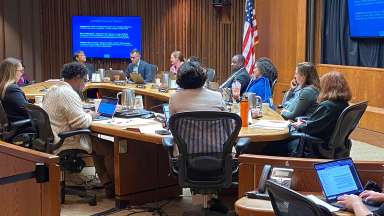Update, posted 5/13/24
On May 7, Raleigh City Council voted to enact the following changes City Ordinance (2024) 627:
- Extend Council member terms to fours years with staggered elections starting in 2026. This means Council members and the Mayor will serve for four years, with approximately half of the members running every two years.
- Switch to a non-partisan primary election format. This means all candidates in a district will be on the March primary ballot, and the top two candidates are chosen for the November ballot.
City residents may file a referendum petition with at least 5,000 signatures from qualified voters on or before June 13, 2024, should residents wish to make the ordinance effective only upon a vote of the people at the next election.
Original Article, posted 4/22/24
Raleigh City Council is considering changes to the municipal election process and is seeking community feedback. The City will hold an information workshop on Wednesday, May 1 at Chavis Community Center from 6 p.m. until 8 p.m. Workshop participants will be asked a series of questions to help inform Council’s decision-making. Participants planning to attend are encouraged to register online.
There are three items under consideration for these election changes. The three items have been grouped into two resolutions. Municipal election changes can be complicated—the information below will help you navigate the proposed changes.
City Council must act on these resolutions by adopting corresponding ordinances by May 21. For each ordinance, they can choose to:
- Have the ordinance placed on the 2024 ballot. If the ballot measure passes, the ordinance will be implemented; OR,
- Implement the ordinance for the 2026 election without a ballot measure.
Ordinance One
Item One: Addition of three district seats.
What does this mean?
Currently, City Council consists of eight members, including the Mayor. If three additional district seats are added, City Council’s size will increase to 11 members, which would include eight district seats, two at-large seats, and the Mayor.
Ordinance Two
Item Two: Change from two-year terms to four-year staggered terms.
What does this mean?
City Council and the Mayor currently serve two-year terms and all members are elected in the same election cycle. If this ordinance is adopted, City Council and the Mayor would serve four-year terms, with approximately half of the members running every two years. To implement the staggered terms, beginning in 2026, half of the City Council would run for two-year terms expiring in 2028. The other half would run for four-year terms expiring in 2030. Those City Council members running for two-year terms in 2026, would then transition to running for four-year terms in 2028.
Item Three: Change from a non-partisan plurality to a non-partisan primary election format.
What does this mean?
A plurality election is when all candidates are on the November ballot, and the candidate with the most votes wins. A primary election is when all candidates are on the March primary ballot, and the top two candidates are chosen for the November ballot. The candidate with the most votes in November wins. In a primary election format, four candidates would be on the November ballot for the two at-large seats.
Current City Council Structure
To learn more about our current City Council structure, watch the My Local Government 101 video.
